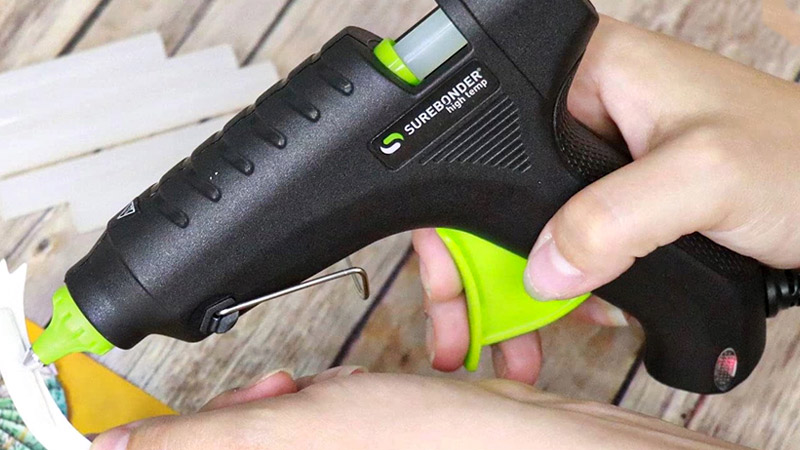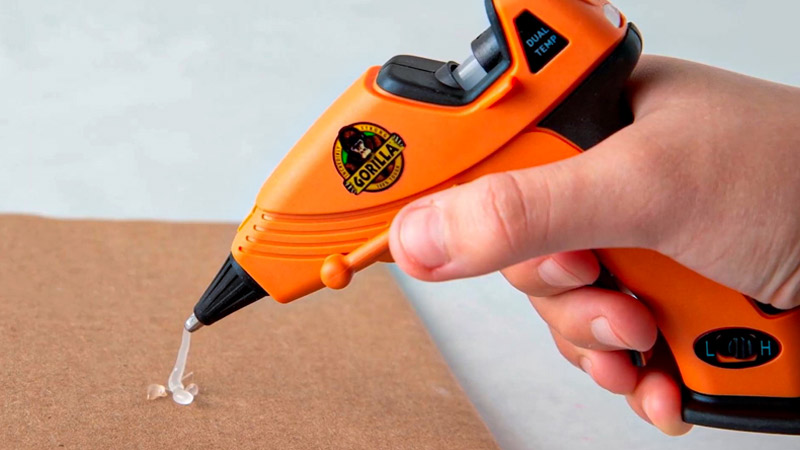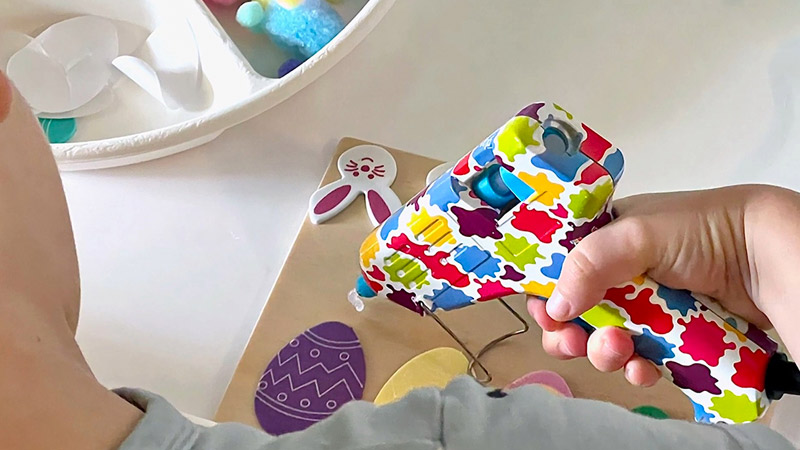Selecting the correct glue gun temperature is pivotal for crafting with versatile foam materials. Craft foam, renowned for its adaptability, demands precision regarding adhesive application.
High-temperature glue guns, operating at around 380°F (193°C), offer robust bonds, ideal for denser and heat-resistant foams.
Conversely, low-temperature glue guns at approximately 250°F (121°C) cater to more delicate foams, preventing distortion or melting during bonding.
Navigating this temperature balance is essential for ensuring a secure connection without compromising the integrity of your craft foam projects.
This guide explores the nuances of glue gun temperatures to empower your crafting endeavors with precision and creativity.

What Is Craft Foam?
Craft foam is a versatile and lightweight material widely used in creative projects. It is a synthetic foam material, often made from substances like polyethylene or EVA (ethylene-vinyl acetate).
Craft foam is popular for its flexibility, durability, and ease of manipulation and is available in various thicknesses, colours, and textures. It is commonly used in crafting, DIY projects, and hobbies to create costumes, decorations, and educational materials.
Craft foam can be easily cut, shaped, and glued, making it a favourite among artists and hobbyists for its adaptability.
What Glue Gun Temp Do I Use for Craft Foam? 2 Types of Glue Gun
When working with craft foam, the appropriate glue gun temperature depends on your foam type. Generally, there are two types of glue guns: high-temperature and low-temperature.
Here’s a guideline based on the common types of craft foam:
1. High-Temperature Glue Gun (Around 380°F or 193°C)
High-temperature glue guns suit dense and heat-resistant craft foams such as polyurethane, neoprene, and silicone foam.
Operating at around 380°F, these glue guns provide a robust and durable bond, making them ideal for projects that require stability and support.
They are particularly effective when working with foam that can withstand higher temperatures without melting or deforming.
2. Low-Temperature Glue Gun (Around 250°F or 121°C)
A low-temperature glue gun is recommended for more delicate craft foams like polystyrene and EVA foam. Operating at around 250°F, these glue guns prevent the risk of melting or distorting the foam during bonding.
The lower temperature facilitates a softer and more flexible bond, making it suitable for projects that demand a more malleable connection.
How to Determine the Right Glue Gun Temperature for Craft Foam?

Determining the right glue gun temperature for craft foam is a crucial step to achieve a secure bond without causing damage to the material.
Here’s a step-by-step guide to help you find the optimal temperature:
Know Your Craft Foam
Different types of craft foam have varying heat resistance. Understand the specific characteristics of the foam you’re using, including its melting point, thickness, and density.
Check Manufacturer Recommendations
Refer to the manufacturer’s recommendations for both the craft foam and the glue gun. These guidelines often provide valuable information on the suitable temperature range for bonding.
Start with a Low Temperature
Begin with a lower temperature setting on your glue gun. This minimizes the risk of damaging the craft foam while allowing you to find the optimal temperature gradually.
Perform Small Tests

Apply a small amount of glue on a scrap or inconspicuous area of the craft foam. Observe how the foam reacts to the glue at the chosen temperature. Look for a strong bond without signs of melting or warping.
Gradually Increase the Temperature
If the initial test seems too cool and doesn’t provide a strong enough bond, gradually increase the temperature of the glue gun. Repeat the process, testing on small areas until you find the optimal setting.
Consider Project Size and Complexity
The size and complexity of your craft foam project may influence the required glue gun temperature. You might need a higher temperature for a secure and lasting bond for larger projects or intricate designs.
Balance Strength and Foam Integrity
Find a balance between achieving a strong bond and preserving the integrity of the craft foam. Avoid using a temperature that is excessively high, as it may lead to melting or warping.
Test Different Temperatures
Don’t be afraid to test a range of temperatures. Crafting is a creative process, and experimentation helps you find the perfect balance for your specific project.
Consider the Glue Gun Type
Different glue guns, such as high temp and low temp, offer varying temperature ranges. Choose the type of glue gun that aligns with the needs of your craft foam project.
Document Your Findings
Record the best temperatures for your specific craft foam and glue gun combination. This documentation can be valuable for future projects.
4 Types of Glue Do I Need for Craft Foam
There are different types of glue that can be used for craft foam, depending on the project and the desired result.
Some of the most common ones are:
Hot glue

Hot glue is a fast and easy way to glue craft foam together. It works well for small pieces and simple shapes. However, hot glue can melt or warp the craft foam if the temperature is too high or leave visible seams if the temperature is too low.
Hot glue can also be messy and hard to remove if you make a mistake.
Contact cement
Contact cement is a strong and durable glue that creates a permanent bond between two surfaces. It works well for large pieces and complex shapes.
However, contact cement can be toxic and flammable, so you need to use it in a well-ventilated area and wear gloves and a mask. Contact cement can also be tricky to apply and adjust if you make a mistake.
Spray adhesive
Spray adhesive is a convenient and easy way to glue craft foam together. It works well for flat pieces and smooth surfaces. However, spray adhesive can be expensive and wasteful, as you need to cover the entire surface with glue.
Spray adhesive can also be sticky and hard to remove if you make a mistake.
Other glues
There are other types of glue that can be used for craft foam, such as white glue, fabric glue, super glue, etc. However, these glues may not be as effective or suitable as the ones mentioned above.
They may not adhere well to the craft foam, or they may damage or discolour it.
FAQs
Can I use a glue gun on all types of craft foam?
Glue guns are generally suitable for various craft foam types, but matching the glue gun temperature to the specific foam’s characteristics is crucial for optimal results.
Are there safety considerations when using high-temperature glue guns with craft foam?
Yes, safety is essential. Be cautious of potential burns, work in a well-ventilated area, and follow all safety guidelines the glue gun manufacturer provides.
How do humidity or environmental factors affect glue gun temperature choice for craft foam?
Environmental factors, including humidity and temperature, can influence glue gun performance. Consider the ambient conditions and make adjustments for the best results.
When is a low-temperature glue gun more suitable for craft foam projects?
A low-temperature glue gun is ideal for craft foam when working with delicate materials like polystyrene or EVA, preventing melting or distortion.
To Recap
Mastering the art of selecting the appropriate glue gun temperature for craft foam is pivotal in achieving successful and durable projects.
By understanding the characteristics of your foam, adhering to manufacturer recommendations, and conducting small tests, you can strike the perfect balance between strength and foam integrity.
Whether opting for the resilience of high-temperature glue or the gentleness of low-temperature options, this guide empowers crafters to make informed choices.
Crafting with foam becomes a seamless and enjoyable experience when armed with the knowledge to navigate temperature intricacies.
Let your creativity flourish, knowing that the right glue gun temperature ensures your craft foam projects stand the test of time.
Leave a Reply